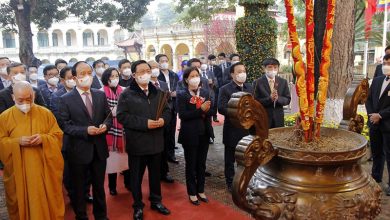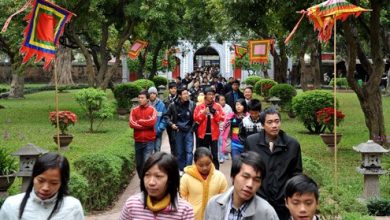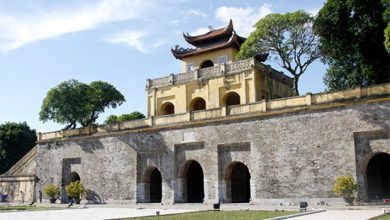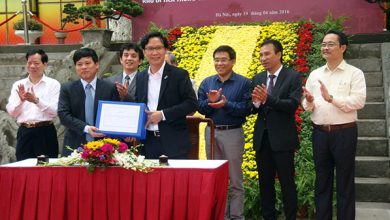International Conference “Ten years of research, conservation and promotion of the values of Thăng Long Imperial Citadel World Heritage Site”
On the occasion of the 10th anniversary of Thăng Long Imperial Citadel’s Inscription on UNESCO World Heritage List (2010 – 2020), the Hà Nội People’s Committee worked with the Vietnam National Commission for UNESCO to organize an International Scientific Conference titled “10 years of research, preservation and promotion of the value of Thăng Long Imperial Citadel World Heritage Site” on 23 November 2020. In attendance at the conference were Member of the Party Central Committee, former Standing Deputy Secretary of the City Party Committee Ngô Thị Thanh Hằng, Vice Chairman of the Hà Nội People’s Committee Ngô Văn Quý and a large number of scientists, domestic and international experts.

Chairpersons on the presidium table.
As he opened the conference, Mr. Ngô Văn Quý, Vice Chairman of the City People’s Committee stressed that since Thăng Long Imperial Citadel was listed by UNESCO as a World Cultural Heritage Site, the Government of the Socialist Republic of Vietnam, the People’s Committee of Hà Nội, as well as relevant ministries and sectors have made investment in the preservation and promotion of the values of the heritage site. The international scientific conference “Ten years of research, conservation and promotion of the values of Thăng Long Imperial Citadel World Heritage Site” is an opportunity for Hanoi authorities to gain a deeper and more comprehensive understanding of the fundamental values of the World Heritage Site of the Imperial Citadel of Thăng Long in various aspects such as urban planning, architecture, landscape, cultural exchanges, conservation and promotion of values, thereby giving orientations and action plans to gradually improve the efficiency of sustainable conservation and promote the multi-faceted values of the heritage site.
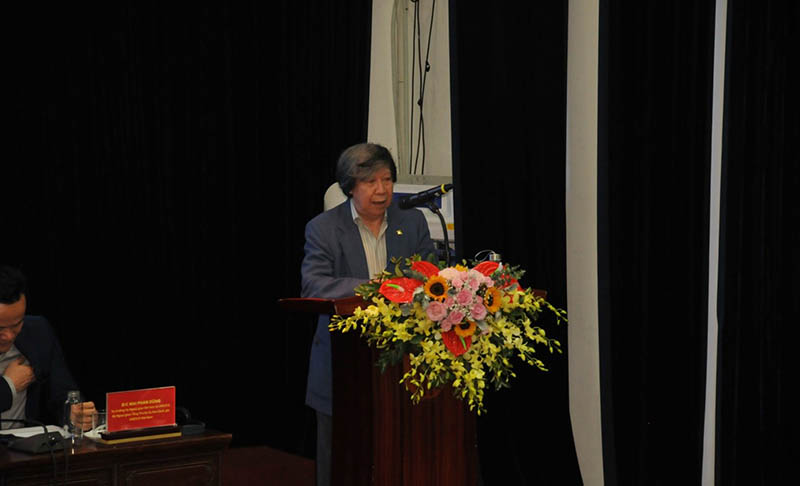
Historian Lê Văn Lan making a speech about the promotion of heritage value.
The conference received nearly 40 presentations from scientists, experts, heritage managers whose discussion focused on two main themes: 1) summarizing and evaluating the results of 10 years of research on the World Cultural Heritage Site of the Imperial Citadel of Thăng Long-Hà Nội (from 2010 to 2020) and orientations for research and restoration of architectural works; 2) sustainable management of heritage sites in Vietnam and the world – experience and orientation in promoting intangible cultural values and heritage education.
At the Conference, Vietnamese and international scientists introduced many new research results on Thăng Long Imperial Citadel in terms of archaeological excavation, architectural identification, and particularly the overall progress of the implementation of eight commitments made by the Government of Vietnam to the World Heritage Committee on Thăng Long Imperial Citadel.
According to Dr. Trần Việt Anh – Director of the Thăng Long-Hà Nội Heritage Conservation Center, since the site inscription on the World Heritage List, the Center has completed and approved the detailed planning project for the conservation, embellishment and promotion of the values of the Hà Nội Ancient Citadel relic site (scale: 1/500) which serves as a basis for implementing component projects according to regulations. The Center has also taken steps to establish a master project to preserve, embellish and promote the values of the Imperial Citadel of Thăng Long. In-depth research and heritage conservation activities have been deployed by the Center, focusing for example on developing a project to study and restore Kính Thiên Palace, a project on restoration of Quảng Chiếu Lantern Festival, a study on court rituals and intangible cultural activities. The implementation of eight commitments made by the Government to the World Heritage Committee has also been taken very seriously, evidenced in the gradual integrated management of relics and monuments, expansion of archaeological excavations, capacity building of staff and organizational apparatus, and efforts to bring the heritage closer to the public.
At the workshop, Mme Ngô Thị Thanh Hằng, Member of the Party Central Committee, former Vice Chairwoman of the Hà Nội People’s Committee, reminisced with a lot of emotion about the historic moment when Thăng Long Imperial Citadel became the 900th heritage site of the world. She also highly appreciated the joint efforts of the central ministries and local agencies, the conscientiousness of domestic and international scientists in the preparation of nomination dossiers and the preservation and promotion of heritage values.
Assoc. Dr. Trần Đức Cường, President of the Vietnam Association of Historical Sciences, former Vice President of the Vietnam Institute of Social Sciences (now the Vietnam Academy of Social Sciences) movingly recalled the day when the first archaeological pit was excavated and the joyful moment of excitement when news was heard about the Citadel’s World Heritage designation: “Between the first shovels dug into the ground and the inscription on the World Heritage List were numerous days of concerted efforts of scientists, agencies, ministries and the authorities of Hà Nội who all put their best efforts into getting the Imperial Citadel of Thăng Long inscribed”, said Assoc. Dr. Trần Đức Cường.
According to Dr. Nguyễn Văn Sơn – President of the Hà Nội Historians’ Association, in the past 10 years, archaeologists have conducted excavations in the immediate vicinity of the Dragon Steps to reveal the main area of Kính Thiên Palace. There have been a number of scientific grounds and directions to help restore the space of Kính Thiên Palace. For example, the focus of restoration work should be on trying to understand the structure, location, scale and appearance of Kính Thiên Palace of the Lê Dynasty, together with understanding the main halls of Càn Nguyên, Thiên An during the Lý – Trần dynasties. Assoc. Prof. Dr. Bùi Minh Trí – Director of the Institute of Imperial Citadel Studies (affiliated with Vietnam Academy of Social Sciences) remarked that archaeological discoveries in recent years at the Imperial Citadel of Thăng Long have found ample authentic evidence of the architectural model of the palace of the Lý Dynasty, where brackets (dougong) were commonly employed. Similar models can easily be found in the palaces in China, Japan, Korea. However, the scale, the number of bays or compartments and the specific location of Kính Thiên Palace remains a mystery that scientists are still trying to solve. As a result, most of the reconstruction work now has not gone any further than 3D drawings.
In their presentations, international experts also made a number of proposals related to the preservation and embellishment of French buildings in the heritage site, and the renovation and transformation of the Vaxuco building into an exhibition area of royal artefacts.
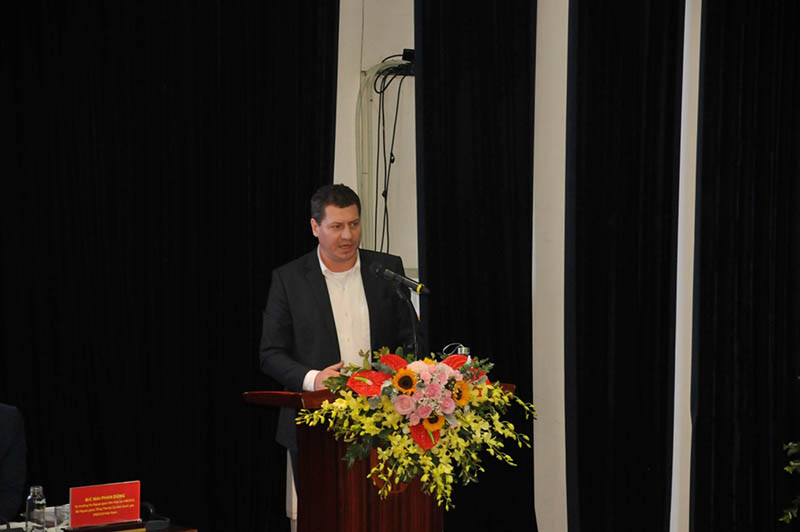
Foreign experts presenting papers at the conference.
With regard to the second theme, participants at the conference generally focused on making high appreciation of the work of promoting the values of the Heritage Site in recent years, especially the heritage education and public education programs. Many scientists and professionals have proposed conscientious ideas which help bring heritage closer to the public. Ms. Phạm Thị Thanh Hường of UNESCO Office in Hà Nội suggested that Thăng Long Imperial Citadel should be given more investment in terms of interpreting and re-creating historical and cultural space, so tourists can easily access and visualize. There should also be better connection with the monuments around Hà Nội to tell the story of Thăng Long – Hà Nội, about the rich and unique craft villages and cultural traditions. At the same time, artists and youths should be involved, taking advantage of the initiatives and creativity of the young generation in preserving and preserving heritage.
Historian Lê Văn Lan believed that in recent years, the Center has taken the right direction in placing focus on young audiences, choosing the right audience, the right time and the right topics such as those associated with the key traditional holidays like Tet or Mid-Autumn Festival to equip children with useful activities and knowledge.
In concluding the Conference, Assoc. Dr. Trần Đức Cường, President of Vietnam Association of Historical Sciences emphasized that over the past ten years, research, preservation and value promotion of Thăng Long Imperial Citadel heritage have been on the right track, ensuring implementation of UNESCO recommendations. In the coming time, Hà Nội authorities need to direct the Thăng Long – Hà Nội Heritage Conservation Center to focus on studying the Kính Thiên Palace area, collecting scientific data to restore Kính Thiên Palace so as to meet the demand of both the general public and professionals.
Thăng Long – Hà Nội Heritage Conservation Center

